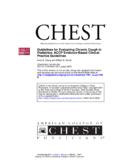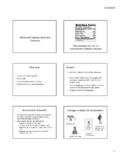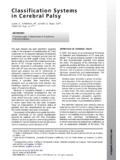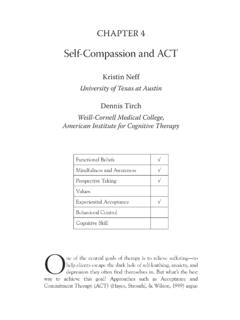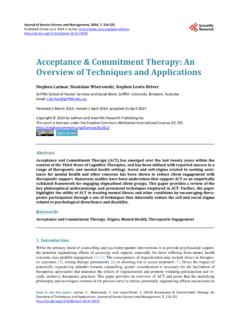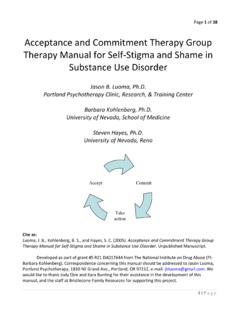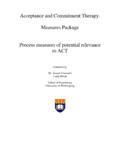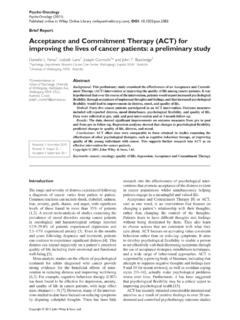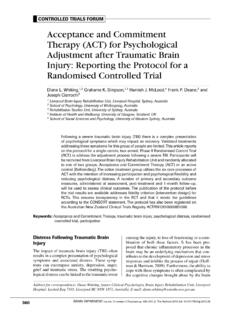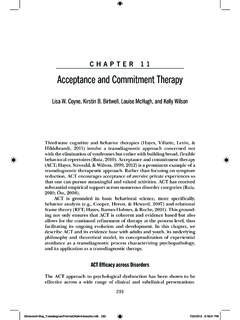Transcription of Acceptance and commitment Therapy
1 1 Acceptance and commitment Therapy Psychotherapy Update 2 Joseph Rhinewine, PhD Portland Mindfulness Therapy Open-source Material: Association for Contextual Behavioral Science 3 What is ACT? A detailed system of psychotherapy Rooted in empirical science emerging from radical behaviorism (BF Skinner) Uses Acceptance & Mindfulness processes and commitment and Behavior Change processes to produce greater psychological flexibility Part of 3rd Wave of Cognitive-Behavioral Therapies 4 Behavior Therapy : 1st Wave Treatments based on well established basic learning principles for Systematic Desensitization Classical conditioning Behavior Modification Operant conditioning 5 Behavior Therapy : 2nd Wave Examining cognition as behavior to be changed Cognitive Therapy (Beck) Rational-Emotive Behavior Therapy RT -> RET -> REBT.
2 ALBERT 6 Behavior Therapy : 3rd Wave Mindfulness changing relationship to thoughts Focus on FUNCTION, not FORM of cognitive events Mindfulness-Based Stress Reduction (MBSR, Jon Kabat-Zinn) Dialectical Behavior Therapy (DBT, Marsha Linehan) 7 What do we mean by function not form? In traditional CBT: FORM Physiology Emotions Behaviour Thoughts & Beliefs The Environment 8 What do we mean by function not form? In traditional CBT: FORM Emotions Behaviour Thoughts & Beliefs The Environment Physiology Anxiety symptoms People will think I m a freak!! Fear Avoid social situations This is distorted, catastrophic: change it and all will be well This is a safety behavior, change it and the thought will change Change those two and these will change 9 Problems with 2nd-Wave Model Mechanistic It has difficulty explaining the actual effects of cognitive Therapy People often dont stop having negative thoughts, but they buy into them less We can have emotional reactions without apparent thoughts We can have thoughts about distressing things without having strong emotions How is it that thoughts cause actions?
3 10 Physiology Emotions Behaviour Thoughts & Beliefs The Environment What do we mean by function not form? In Acceptance & commitment Therapy : FUNCTION These are not targets for change in content This link is a target This link is a target This link is a target 11 What do people normally do with distressing private experiences? Pain, unpleasant physiological sensations, negative memories, unwanted urges: Control them We don t like having them We are taught as children to develop emotional and behavioral control If something aversive happens outside in the world, often getting rid of it WORKS 12 What happens if we try to control private experiences? What do your patients do to try and avoid having pain, unpleasant feelings, thoughts, memories etc?
4 Do these things lead them to more vitality, a greater sense of fulfilment, meaning and purpose in life? So maybe: Control is part of the problem, not the solution 13 Living with Pain vs. Pain of not Living? Having unpleasant private experiences is hard. Its normal (and healthy) to suffer, to get upset Illness, Loss, not getting what you want or need, fear of the unknown, change But in your efforts to avoid having that, life SHRINKS Pain of presence replaced with pain of ABSENCE 14 How does ACT approach this? Stopping fruitless attempts at control: Creative Hopelessness Helping the person to make contact with what values are important to them Defining values in relation to achievable goals Promoting Acceptance and contact with whatever private experiences are aversive or difficult 15 How does ACT approach this?
5 Taking committed action towards valued goals, even in the presence of aversive private events Experiential exercises Contact with Present-moment sensations Increased Willingness to have discomfort Defusion from thoughts, You are not your thoughts Self-As-Context Contacting the Observing Self 16 The ACT Model of Psychopathology Psychological inflexibility Dominance of Conceptualized Past & Future Experiential avoidance Cognitive Fusion Attachment to the conceptualized self Lack of Values Clarity, dominance of pliance and avoidant tracking Inaction, impulsivity or avoidant persistence 17 The Positive Psychological Processes ACT Seeks to Strengthen Psychological Flexibility Being in the present moment Acceptance / Willingness Defusion Self as Context Values Committed Action 18 Key Concepts in ACT Components of ACT Being in the present moment Acceptance / Willingness Defusion Self as Context Values Committed Action Acceptance & Mindfulness Processes 19 Key Concepts in ACT Components of ACT Being in the present moment Acceptance / Willingness Defusion Self as Context Values Committed Action commitment and Behavior Change Processes 20 Key Concepts in ACT Psychological Flexibility Contacting the present moment
6 Acceptance / Willingness Defusion Self as Context Values Committed Action 21 The Question Given whats important to me, what am I willing to do and experience to move me in that direction, in this moment? Choose Again! Context-sensitivity: Not Always So (S. Suzuki) 22 Evidence Base for ACT Controlled studies have providence evidence of efficacy for: Work stress, social phobia, agoraphobia, stigma and burnout in substance abuse counselors, depression, substance misuse, smoking cessation, weight loss, diabetes, chronic pain, epilepsy, psychosis, borderline personality disorder, trichotilomania, tinnitus, end-stage cancer (Hayes, et al 2006) 23 Evidence base for ACT (Hayes 2006) Overall effect sizes across all RCTs Vs.
7 # Post d N F-Up d N F-Up weeks No Rx/ TAU 9 .99 248 .72 176 21 Active Rx 15 .56 793 .82 727 36 CT / CBT 6 .55 205 .55 120 44 All 24 .66 1041 .8 903 33 24 This graph contains a cumulative record of the randomized clinical trial on Acceptance and commitment Therapy through June 20, 2012 (including articles in press). 25 Meta-analysis of ACT versus CBT Effect Sizes: Overall (15 studies) WL Control (2 studies) TAU (5 studies) Active Treatment (8 studies) Lars Goran Ost (BRAT 2008) Evidence base for ACT 26 Also: Background variables ACT CBT p value Numbers starting NS Attrition (% starters) NS No of weeks < No of hours 22 NS Months follow up NS Lars Goran Ost (BRAT 2008) Evidence base for ACT 27 Using a scale to rate methodological rigour ACT studies on average are significantly poorer quality than recent CBT studies.
8 Total quality score (max 44) ACT = (SD = ) CBT = (SD = ) p < Lars Goran Ost (BRAT 2008) Evidence base for ACT 28 ACT studies are poorer on criteria such as; Representativeness of the sample, reliability of diagnosis, reliability and validity of outcome measures, assignment to treatment, number of therapists, therapist training and experience, treatment adherence checks, control of other treatments. Lars Goran Ost (BRAT 2008) Evidence base for ACT 29 ACT studies are equivalent on other criteria: clarity of sample description, severity / chronicity of disorder, specificity of measures, use of blind assessors, assessor training, design, power analysis, assessment points, manualized specific treatments, checks for therapist competence, handling of attrition, statistical analyses and presentation of results, clinical significance of results.
9 Lars Goran Ost (BRAT 2008) Evidence base for ACT 30 A further recent review: Pull, C. B. (2009) Current Empirical Status of Acceptance and commitment Therapy , Current Opinion in Psychiatry, Vol. 22, 55-60. General conclusion is that ACT shows promise across a wide range of disorders (mainly focussed on adult clinical problems) The mechanisms of change appear to fit with the models processes and are different to CT based mechanisms The research evidence is not sufficiently developed to allow us to compare efficacy between therapies Evidence base for ACT 31 Beyond 32 Importance of Mediation & Moderation Moderation Treatment matching Mediation Identifying core processes Across treatments Across diagnoses New area of research 33 If This Model is Valid You should be able to see correlational evidence that experiential avoidance, cognitive fusion.
10 And so on are associated with poor outcomes The primary vehicle for population based correlational studies so far has been with the Acceptance and Action Questionnaire (AAQ, Hayes, Luoma, Bond, Masuda & Lillis 2006) 34 Origin of the AAQ Although the AAQ is often said to be a measure of experiential avoidance, the original item pool focused on all major ACT processes These 9-16 items (depending on the version) cover a wide range of issues, including Acceptance , defusion, and action The AAQ seems to be a measure of psychological flexibility more generally, emphasizing the parts of the model that we can tap easily within the existing language community. 11/22/13 35 AAQ I - 9 Item 1.


